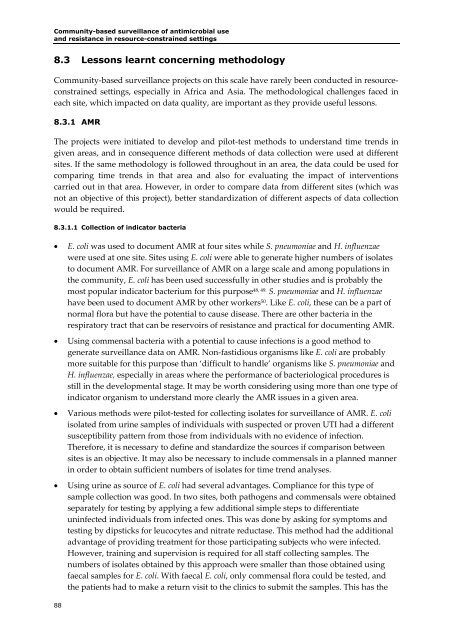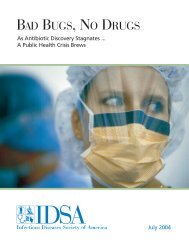Community-Based Surveillance of Antimicrobial Use and ...
Community-Based Surveillance of Antimicrobial Use and ...
Community-Based Surveillance of Antimicrobial Use and ...
- No tags were found...
You also want an ePaper? Increase the reach of your titles
YUMPU automatically turns print PDFs into web optimized ePapers that Google loves.
<strong>Community</strong>-based surveillance <strong>of</strong> antimicrobial use<strong>and</strong> resistance in resource-constrained settings8.3 Lessons learnt concerning methodology<strong>Community</strong>‐based surveillance projects on this scale have rarely been conducted in resourceconstrainedsettings, especially in Africa <strong>and</strong> Asia. The methodological challenges faced ineach site, which impacted on data quality, are important as they provide useful lessons.8.3.1 AMRThe projects were initiated to develop <strong>and</strong> pilot‐test methods to underst<strong>and</strong> time trends ingiven areas, <strong>and</strong> in consequence different methods <strong>of</strong> data collection were used at differentsites. If the same methodology is followed throughout in an area, the data could be used forcomparing time trends in that area <strong>and</strong> also for evaluating the impact <strong>of</strong> interventionscarried out in that area. However, in order to compare data from different sites (which wasnot an objective <strong>of</strong> this project), better st<strong>and</strong>ardization <strong>of</strong> different aspects <strong>of</strong> data collectionwould be required.8.3.1.1 Collection <strong>of</strong> indicator bacteria• E. coli was used to document AMR at four sites while S. pneumoniae <strong>and</strong> H. influenzaewere used at one site. Sites using E. coli were able to generate higher numbers <strong>of</strong> isolatesto document AMR. For surveillance <strong>of</strong> AMR on a large scale <strong>and</strong> among populations inthe community, E. coli has been used successfully in other studies <strong>and</strong> is probably themost popular indicator bacterium for this purpose 48, 49. S. pneumoniae <strong>and</strong> H. influenzaehave been used to document AMR by other workers 50 . Like E. coli, these can be a part <strong>of</strong>normal flora but have the potential to cause disease. There are other bacteria in therespiratory tract that can be reservoirs <strong>of</strong> resistance <strong>and</strong> practical for documenting AMR.• Using commensal bacteria with a potential to cause infections is a good method togenerate surveillance data on AMR. Non‐fastidious organisms like E. coli are probablymore suitable for this purpose than ‘difficult to h<strong>and</strong>le’ organisms like S. pneumoniae <strong>and</strong>H. influenzae, especially in areas where the performance <strong>of</strong> bacteriological procedures isstill in the developmental stage. It may be worth considering using more than one type <strong>of</strong>indicator organism to underst<strong>and</strong> more clearly the AMR issues in a given area.• Various methods were pilot‐tested for collecting isolates for surveillance <strong>of</strong> AMR. E. coliisolated from urine samples <strong>of</strong> individuals with suspected or proven UTI had a differentsusceptibility pattern from those from individuals with no evidence <strong>of</strong> infection.Therefore, it is necessary to define <strong>and</strong> st<strong>and</strong>ardize the sources if comparison betweensites is an objective. It may also be necessary to include commensals in a planned mannerin order to obtain sufficient numbers <strong>of</strong> isolates for time trend analyses.• Using urine as source <strong>of</strong> E. coli had several advantages. Compliance for this type <strong>of</strong>sample collection was good. In two sites, both pathogens <strong>and</strong> commensals were obtainedseparately for testing by applying a few additional simple steps to differentiateuninfected individuals from infected ones. This was done by asking for symptoms <strong>and</strong>testing by dipsticks for leucocytes <strong>and</strong> nitrate reductase. This method had the additionaladvantage <strong>of</strong> providing treatment for those participating subjects who were infected.However, training <strong>and</strong> supervision is required for all staff collecting samples. Thenumbers <strong>of</strong> isolates obtained by this approach were smaller than those obtained usingfaecal samples for E. coli. With faecal E. coli, only commensal flora could be tested, <strong>and</strong>the patients had to make a return visit to the clinics to submit the samples. This has the88




